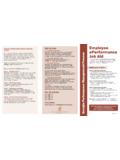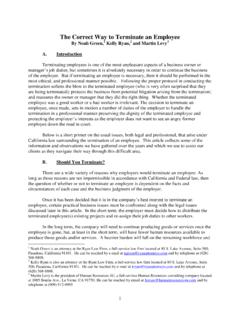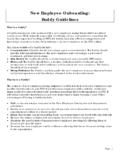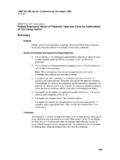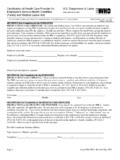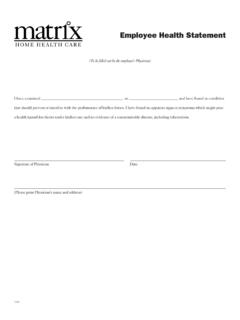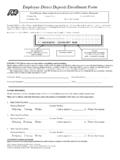Transcription of WRITING AN EMPLOYEE RELOCATION OFFER LETTER
1 CAPRELO PRESENTS. WRITING AN EMPLOYEE . RELOCATION OFFER LETTER . WRITING AN EMPLOYEE RELOCATION OFFER LETTER . Inside Relocating is a Major Life Event 1 Discuss the RELOCATION First 1. Understand the New Role 2. Understand your RELOCATION Policy 3 RELOCATION Expenses Moving Household Goods Home Marketing Assistance Home Finding Assistance Final Thoughts 5. Contact Information Sample RELOCATION LETTER 6 WRITING AN EMPLOYEE RELOCATION OFFER LETTER . RELOCATION IS A MAJOR LIFE EVENT. Health care professionals acknowledge that people feel stress when in situations that pose significant changes to their daily routine. These are known as major life events. RELOCATION ranks high on the list because it often requires an EMPLOYEE to sell their home, move the family to a new state or country and change many of their typical routines.
2 Your EMPLOYEE transfer or assignment OFFER LETTER needs to cover several important topics, but without adding stress in the process. The key to drafting an effective LETTER begins with knowing your EMPLOYEE and focusing on them and their family. The internet abounds with sample templates to help you draft a RELOCATION LETTER . Unfortunately, many of them begin something like this: Dear Mr. Jones, This LETTER is to inform you that you will be transferred effective on [date] to our location in . That's a bit abrupt. Let's take a fresh look at the topics you need to cover and how to write an effective RELOCATION LETTER . DISCUSS THE RELOCATION FIRST. Relocating an EMPLOYEE benefits the company. You may need to add talent to a business unit in a distant city, or to reduce it at the EMPLOYEE 's current location.
3 You may want to move a manager to provide new leadership in another territory. You may even want to give a high-potential EMPLOYEE broader experience as part of a career development plan. No matter the reason, be sure you or the appropriate manager(s) discuss those reasons with the EMPLOYEE long before you write the LETTER . Having a detailed discussion gives you the opportunity to create enthusiasm about a new role: It can increase the likelihood of an accepted OFFER . It can provide a platform for discussing your global mobility policy and company-provided financial assistance. It allows you to be clear about the specific skill-building and learning opportunities available to your EMPLOYEE in the new role.
4 It gives you an opportunity to show that the company values the EMPLOYEE and wants to make an investment in their future. It lets you show that the EMPLOYEE is important to the growth of the business. 1 WRITING AN EMPLOYEE RELOCATION OFFER LETTER . Holding a discussion shows respect for the EMPLOYEE and allows you to craft a LETTER that applies to that individual. In turn, you're more likely to increase loyalty and productivity . and to reduce the chance of a RELOCATION being declined. Rather than opening the LETTER with a recap of your policy and salary, begin with highlights of the discussion you held with the EMPLOYEE . The EMPLOYEE will likely review the LETTER with their spouse or partner; recapping the upsides to relocating will help the spouse be supportive.
5 UNDERSTAND THE NEW ROLE. If your EMPLOYEE 's job title and responsibilities remain the same in the new location, be sure to convey to whom the EMPLOYEE will report and the duration of the transfer or assignment. For employees taking on new responsibilities, you'll also want to communicate the following: The EMPLOYEE 's new job title or position. New and additional responsibilities and duties. Those duties and activities for which the EMPLOYEE will no longer be responsible. A description of any increased benefits, salary or bonuses. Include an appropriate repayment agreement. Similar in some ways to an OFFER LETTER to a prospective new EMPLOYEE , this section of the LETTER focuses on the specifics of the new role.
6 It documents the job title, salary and related matters to eliminate misunderstandings later. Be sure your LETTER contains: The EMPLOYEE 's full name and current home address. Department names: current department and the new destination department. The effective date that the EMPLOYEE reports to the new location. The name of the EMPLOYEE 's new supervisor. The LETTER or memo should be dated and signed by the appropriate manager. The date by which the RELOCATION benefits must be used. With all of this pertinent information, you're now ready to dive into the specifics of your company's global mobility policy and provide the EMPLOYEE with an explanation of their entitlements. 2 WRITING AN EMPLOYEE RELOCATION OFFER LETTER .
7 UNDERSTAND YOUR RELOCATION POLICIES. Your LETTER should recap or summarize the portions of your policy applicable to the EMPLOYEE . Among the issues your policy addresses, include the points summarized in the next four topics for two reasons: 1. These topics are the most costly components of an assignment or transfer. 2. They are usually the greatest stressors to an EMPLOYEE and can cause reduced productivity. RELOCATION Expenses Over the past decade, companies have adjusted RELOCATION allowances to reflect changes in the economy and their market sectors. Ninety percent of companies responding to a 2016 CapRelo survey use a multi-tiered approach to determine what portion of RELOCATION expenses will be paid by the company.
8 How those tiers are defined varies across companies. Overall, most define their tiers according to: Salary or job level Whether the EMPLOYEE is a homeowner or renter Whether the RELOCATION is initiated by the company or the EMPLOYEE Exempt versus non-exempt status Whether the move is a lateral move or a promotion In WRITING your LETTER , review your policies to determine what is relevant to the particular EMPLOYEE . While it's not recommended that you copy company policy verbatim into the LETTER , you should summarize: Specific expenses and the amounts the company pays for directly. Types of expenses that can be reimbursed, along with any limits. Note whether the transferee or assignee is required to document each expense, to submit a consolidated summary or will be given a lump sum amount for miscellaneous expenses.
9 Expenses the EMPLOYEE is responsible for paying. Do not provide advice on the tax consequences of how your company funds or reimburses RELOCATION expenses. Encourage them to seek advice from a tax professional if questions arise. Moving Household Goods The average cost companies paid for moving employees' household goods was $11,583, according to a 2016 Worldwide ERC survey. That cost rose by 25 percent over ten years and can be expected to continue as a significant part of your overall RELOCATION expense. 3 WRITING AN EMPLOYEE RELOCATION OFFER LETTER . The moving cost varies widely depending upon whether the EMPLOYEE is a renter or a home owner (home owners tend to have more household goods to move), the distance between current and destination addresses and the size of the family.
10 The cost of storage and valuation coverage for household goods also come into play if the EMPLOYEE will be moving into furnished temporary housing. Your LETTER should specify the amount the company will pay for household goods transport, storage and valuation along with any limitations or restrictions. In addition, include any specific costs the EMPLOYEE will be responsible for paying, even if your policy provides a lump sum for out-of-pocket expenses. Home Marketing Assistance Providing assistance to an EMPLOYEE in selling their current home is important. It allows your EMPLOYEE to relocate without the added stress of trying to sell their home from afar, which can distract from their job. Your company may OFFER assistance to the EMPLOYEE based on a Buyer Value Option, an Appraised Value, an Amended Value Option or another approach.

